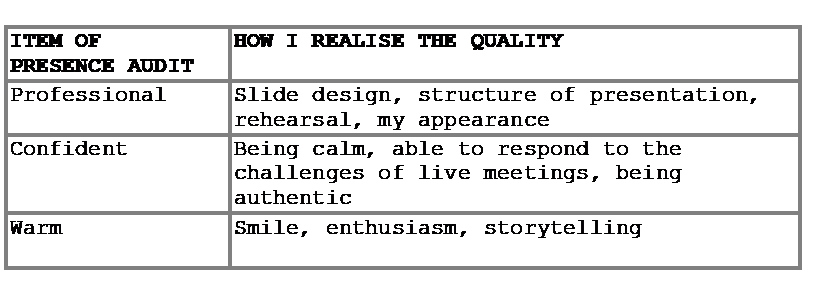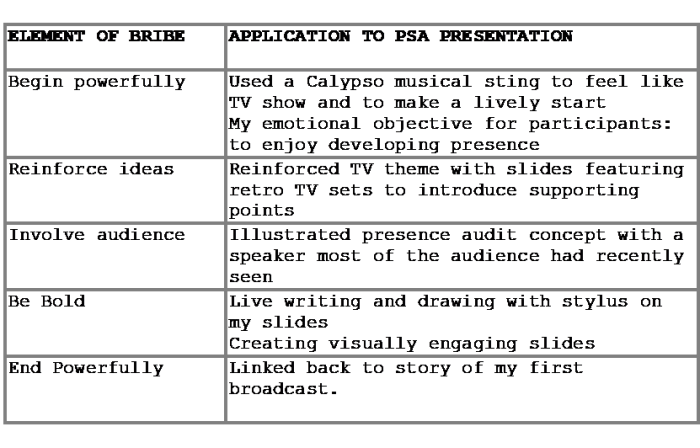“5-4-3-2-1. Cue Jacqui!”
Those words, spoken by a director into my ear piece, launched my first live television broadcast. That bulletin was also my first experience of remote speaking.
Many years later, those skills are more relevant than ever. Online meetings will continue to dominate business communication throughout 2021 and well beyond.
The focus is now on increasing engagement. Videoconferencing platforms are regularly rolling out new features. For example, this year users of Teams will see several improvements to PowerPoint. The thinking behind these innovations is greater impact and interaction.
“The way I look at it now, is we need to make presentations more like TV shows” says Nicole Herskowitz, general manager of Microsoft Teams.
It’s one thing to make the tech more like TV but that only works if the speakers are more like anchors. It’s time to learn from TV anchors how to make online speaking clear and compelling?
THREE LITTLE WORDS
As a news anchor for BBC TV, I was always clear about how I wanted to come across to viewers. For me, three particular words capture my on-screen presence. I always want show up as professional, confident and warm. I call it my presence audit.
The benefit of having simple, clear self focus is tremendous. Neuroscience informs us that having a presence audit helps speakers see themselves more objectively and become more open to feedback. This in turn helps speakers align their behaviour with their intentions and have a more consistent presence.
The audience benefit too. They experience a confident speaker who has self clarity derived from a presence audit. Through digital screens and speakers, the audience sense confidence from the sound of the presenter’s voice, facial expressions and upper body language.
To conduct your own presence audit is straightforward. Think about recent online meetings and your presence in these meetings. What words would you use to describe your presence? Write them down.
Now think about yourself at your best. What’s your presence like when you are firing on all cylinders? Write down all the adjectives that come to mind.
It can be useful to ask colleagues, and even clients, for their words to describe your presence. Capture all the input you receive. The goal is to have three words that resonate with you in a deep and authentic way.
If you’re still stuck with deciding on your three words, consider your favourite TV or social media presenters. How would you describe their presence? Sometimes the presenters we are drawn to have the qualities we want in ourselves.
Once you have your three words, use them to get regular feedback from colleagues to develop your online presence. Doing this will narrow the perception gap. That’s the difference between how you perceive yourself and how others see you.
Think about what else you can do to embody the qualities identified in your presence audit.
As already mentioned, the words I use to guide my online presence are professional, confident and warm. The table below shows how I express those qualities.
 Figure 1: Presence Audit
Figure 1: Presence Audit
THREE QUESTIONS
The language of TV is clear and compelling. It has to be. If information is unclear, TV audiences don’t spend time figuring out meaning, they disengage. If an anchor has a dull speaking style, audiences switch off – literally.
Online audiences are much the same. Getting attention is not easy and people are often distracted when working from home. Maintaining attention can be even tougher. What you say HAS to engage – and quickly. The following three questions can help.
● What is the big point?
● What are the supporting points?
● How compelling is my message?
What is your big point? This question reduces content to one clear idea. I always find it maddening working out my big point. I tend to brainstorm all over the place and so it takes ages to refine my thinking to one key point.
For example, I recently spoke at the Professional Speaking Association in the UK. When creating the talk, the big point started as ‘how to refresh your speaking presence’. I knew it wasn’t right but it still took me a while to improve it. I eventually got there. My big point was ‘how to develop your speaking presence to be more compelling and attractive to clients’. Boom. After that, creating supporting points was a doddle.
A few tips on supporting points. Use only a few to avoid information overload. I rarely use more than five but the work of American psychologist George Miller suggests seven may be the magic number. He looked at short term memory and the number of items people could recall.
You can also make supporting points more memorable by using themes. Themes effectively chunk ideas together. Psychologist George Miller noted that chunking information made them very easy to remember.
For example, the letters FBICIAUSA can be remembered effortlessly if grouped into 3 chunks which are acronyms: FBI, CIA, and USA.
It is cognitively exhausting trying to follow a poorly structured speech. Interrogate the order in which you explain your ideas. Is the order logical, rational, easy to follow? In my experience, the easier it is to follow ideas, the more likely you are to hold an audience.
Links are a key part of television scripts. They connect stories that are very different so it feels as if the ideas flow and are part of one programme. When speaking online, link supporting points to elevate clarity.
Often links signpost what you have just been speaking about or what you are about to say. In TV, it might look like this:
Looking back: “And the main news so far …”
Looking forward: “And still to come …”
There are many ways to make what you say compelling. I have had great success with an acronym called BRIBE. It stands for:
B – begin powerfully
R – reinforce ideas
I – involve your audience
B – be bold
E – end powerfully.
I used BRIBE to make the presentation to the Professional Speaking Association (PSA) more engaging. See the table below.

Figure 2: BRIBE
VISUAL IMPACT
Visual impact contributes massively to the success of TV and social media. In TV it is achieved in two ways: great graphics and the appearance of presenters. Let’s start with graphics. Watch any TV news bulletin and you will see graphics that are creative, engaging and effective at explaining ideas quickly. The quality of the graphics is down to the skill of experienced and talented graphic designers.
I don’t have any design skills so I attended a short course to improve my understanding of the principles of visual content. If you haven’t got time for a course, I can recommend two useful guides. Take a look at the TED guide – ‘10 Tips for Better Slide Decks’ or ‘Slides that Rock’ on slideshare.net
I also use Canva to design slides and images. Canva is a wonderful graphic design platform for creating quality presentations, documents and other visual content. It is easy to adapt the templates to your own specifications.
It’s well worth making an effort with visuals. Effective graphics connect people to ideas immediately. It’s to do with brain biology. We have 140 million neurons in our visual cortex – that’s an awful lot of processing power.
Directors see presenters as visuals (perhaps not exclusively!) Before going on air, the director pays attention to the set behind the presenter, what the presenter is wearing, make up, lighting etc. All these things enhance the visual impact of the presenter and help engage the viewer.
I encourage you to see yourself as a ‘visual’ before speaking online to clients and colleagues. Be your own director by critiquing your appearance. Ask yourself how effective is my visual impact? Focus on grooming and clothes.
Quick word about lighting. Lighting is always a priority in TV because it makes everyone look so much better. Simple, inexpensive lighting gives better definition. I currently use two LED panels, each the size of a postcard for my lighting. Even if you just use the torch function on an old mobile phone to light yourself, you will remove shadows and look better.
So, now you know the secrets of this TV anchor. Use these tips in online meetings to engage stakeholders and build better business relationships.
Jacqui Harper MBE, MA, Hon Fellow – Crystal Business Coaching








